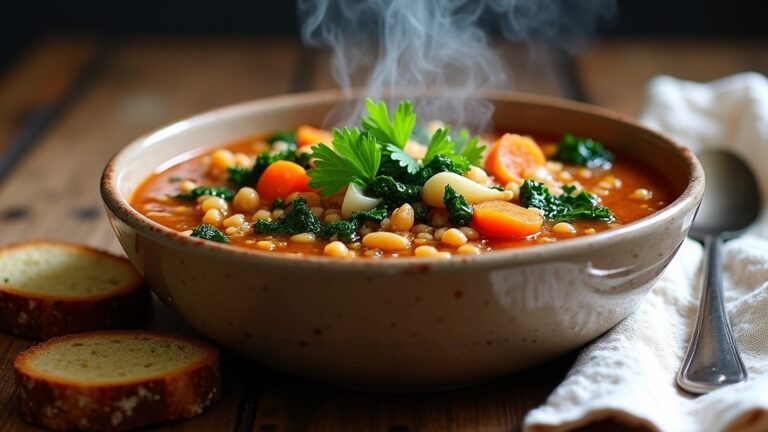Best Spaghetti Recipe
For the best spaghetti recipe, embrace rich flavors with high-quality ingredients. Boil salted water, add spaghetti, and stir occasionally for even cooking. Toss your pasta with a homemade marinara using fresh tomatoes, garlic, and a blend of herbs. Enhance your dish with grated Parmesan and a sprinkle of chili flakes for heat. Pair it with a side salad and crusty bread for a complete meal that brings everyone together. You’ll discover even more exciting flavors and tips ahead!
Contents
History
When you think of spaghetti, it’s hard not to be transported to the sun-soaked streets of Italy, where this beloved dish has its roots. Spaghetti’s Italian origins trace back to the 12th century, with early references to noodles in Southern Italy. Over centuries, it’s undergone a remarkable culinary evolution, influenced by regional ingredients and techniques. You’ll find variations that reflect Italy’s rich culture, from the simple aglio e olio to the more complex ragù alla Bolognese. As you explore this dish, you’ll notice how it has transcended borders, inspiring countless interpretations worldwide. Each bite encapsulates a world of history, inviting you to celebrate freedom through flavors. Enjoy the experience, knowing you’re part of a delicious legacy!
Recipe
When it comes to comfort food, spaghetti holds a special place in many hearts. This classic Italian dish is not only easy to prepare but also incredibly versatile, allowing you to customize it with various sauces and toppings. In this recipe, we will focus on a traditional spaghetti with a rich tomato sauce, perfect for a cozy dinner or a gathering with friends and family. The combination of fresh ingredients and aromatic herbs will create a delightful meal that everyone will enjoy.
To achieve the perfect spaghetti, the quality of your ingredients plays a critical role. Opt for high-quality spaghetti, and use fresh tomatoes or a good-quality canned tomato. Adding garlic, onion, and a blend of herbs will elevate the flavors, making your dish truly special. Don’t forget to finish your spaghetti with a sprinkle of grated Parmesan cheese for an authentic Italian touch.
Ingredients:
- 400g spaghetti
- 2 tablespoons olive oil
- 1 medium onion, chopped
- 3 cloves garlic, minced
- 800g canned crushed tomatoes
- 1 teaspoon dried oregano
- 1 teaspoon dried basil
- Salt and pepper, to taste
- Fresh basil leaves, for garnish
- Grated Parmesan cheese, for serving
To cook the spaghetti, bring a large pot of salted water to a boil. Add the spaghetti and cook according to package instructions until al dente. Meanwhile, in a separate pan, heat the olive oil over medium heat and sauté the chopped onion until translucent. Add the minced garlic and cook for another minute, then stir in the crushed tomatoes, oregano, and basil. Let the sauce simmer for about 15 minutes, allowing the flavors to meld. Once the spaghetti is cooked, drain it and combine it with the sauce, tossing to coat evenly. Serve hot, garnished with fresh basil leaves and a generous sprinkle of grated Parmesan cheese.
For the best results, consider using fresh herbs instead of dried ones, as they can enhance the flavor profile considerably. If you like a bit of heat, adding a pinch of red pepper flakes will give your sauce a nice kick. Additionally, feel free to incorporate vegetables like bell peppers or mushrooms into your sauce for added texture and nutrition. Always taste your sauce before serving and adjust the seasoning as needed. Enjoy your homemade spaghetti with a side of garlic bread for a complete meal!
Cooking Steps
To make the perfect spaghetti, start by boiling a pot of salted water—this step enhances the pasta’s flavor. Once the water’s bubbling, add your pasta and remember to stir occasionally to keep it from sticking. After cooking, drain the pasta thoroughly and give it a light toss with olive oil to finish it off beautifully.
Step 1. Boil Salted Water First
Start by bringing a large pot of water to a rolling boil, making certain to add a generous amount of salt—about one tablespoon for every four quarts of water. This salt not only enhances the flavor of your pasta but also raises the boiling point of the water, creating a perfect cooking environment. The ideal salt concentration in your water is essential; it guarantees your spaghetti absorbs just the right amount of seasoning during cooking. As the water bubbles vigorously, you’ll see steam rising, signaling that you’re ready to plunge into the next steps of your culinary adventure. This is where the magic begins, transforming simple ingredients into a dish that sings with flavor. Enjoy the freedom of creating!
Step 2. Add Pasta to Water
Once the water’s boiling vigorously, it’s time to add the spaghetti. Gently drop the strands into the bubbling cauldron, ensuring you don’t splash hot water. As the pasta types submerge, the water temperature will dip slightly, but don’t worry; it’ll return to a boil in no time. Keep an eye on the pot, and let the pasta dance in the heat—this is where the magic happens! Cooking times vary depending on the type of pasta you choose, so check the package for specifics. Remember, you want that perfect al dente texture, where the spaghetti is tender yet firm to the bite. Embrace this moment, feeling free to experiment with flavors and styles as you create your masterpiece!
Step 3. Stir Occasionally During Cooking
As the spaghetti swirls in the pot, give it a gentle stir every couple of minutes. This stirring technique not only helps prevent the strands from sticking together, but also promotes even cooking consistency. Imagine the noodles dancing in the bubbling water, releasing that delightful aroma. By stirring, you guarantee that every bite of spaghetti is perfectly al dente, with a texture that invites freedom of flavor. Use a wooden spoon or a pasta fork to coax those strands apart, allowing them to soak up all that savory goodness. So, embrace this simple yet essential step—your pasta will thank you for it! Keep an eye on the clock, and enjoy the art of cooking your spaghetti just right.
Step 4. Drain Pasta Thoroughly
After you’ve achieved that perfect al dente texture, it’s essential to drain the pasta thoroughly to prevent it from becoming mushy. Start by lifting the pot off the heat and carefully pouring the contents into a colander. Let gravity do its work, allowing the water to escape while the pasta retains its ideal texture. If you’re feeling adventurous, consider using a few draining techniques, like shaking the colander gently to remove any excess water without damaging the pasta. Avoid rinsing the spaghetti, as that washes away the starch, which helps the sauce cling beautifully. Once drained, your pasta is ready to shine in its next culinary adventure, ensuring each bite is full of flavor and freedom!
Step 5. Toss With Olive Oil
Drizzle a generous amount of high-quality olive oil over your drained spaghetti to enhance its flavor and prevent sticking. The silky texture of the oil will coat each strand, creating a luxurious mouthfeel. Olive oil benefits go beyond just taste; it’s packed with healthy fats that promote heart health and provide antioxidants. As you toss the spaghetti, feel the warmth of the pasta embracing the oil, releasing its aromatic scent. This simple step not only elevates the dish but also allows for greater flavor enhancement when you add your chosen sauce or toppings. Enjoy the freedom to experiment with different oils, infusing your meal with unique nuances. Your spaghetti’s transformation has only just begun—let the culinary adventure unfold!
Nutritional Guide
While you savor each bite of spaghetti, it’s essential to reflect on the nutritional value of this beloved dish. Spaghetti offers various nutritional benefits, like carbohydrates for energy and protein for muscle repair. To enhance the healthfulness of your meal, consider ingredient substitutions such as whole grain pasta or adding veggies for extra fiber and vitamins.
Here’s a quick guide to the nutritional aspects of spaghetti:
| Component | Standard Spaghetti | Whole Grain Spaghetti | Veggie Additions |
|---|---|---|---|
| Calories | 200 | 180 | Varies |
| Fiber (g) | 3 | 6 | 2-4 (varies by veggie) |
| Protein (g) | 7 | 8 | 1-2 (varies by veggie) |
Feel free to experiment with these options!
Final Thoughts
As you wrap up your spaghetti-making journey, it’s worth taking a moment to appreciate not just the delicious flavors but also the versatility this dish offers. You can experiment with countless sauce variations, from classic marinara to rich Alfredo or zesty pesto. Each option transforms your spaghetti into a unique experience, allowing you to cater to any palate. Don’t forget the serving suggestions! Pair your pasta with fresh herbs, grated cheese, or a sprinkle of chili flakes to elevate the dish. Consider adding a side salad or crusty bread for a complete meal. Remember, spaghetti is more than just a recipe; it’s an opportunity to express your culinary creativity and share joyful moments with loved ones. Enjoy every bite!
Frequently Asked Questions
What Type of Spaghetti Is Best for This Recipe?
The best spaghetti shapes depend on your sauce compatibility. Thin spaghetti pairs well with light sauces, while thicker shapes like bucatini hold robust sauces beautifully. Experiment and discover your favorite combination for a delightful dining experience!
Can I Substitute Gluten-Free Pasta?
You can swap in scrumptious gluten-free options. Just remember, cooking times may vary, so keep an eye on your pasta. Enjoy the delightful freedom of flavor while accommodating dietary needs. Happy cooking!
How Do I Store Leftover Spaghetti?
To store leftover spaghetti, place it in an airtight container and refrigerate. For best spaghetti storage, add a splash of olive oil to prevent sticking. Enjoy your delicious leftovers within three to five days for ideal taste!
What Wine Pairs Well With Spaghetti?
When pairing wine with spaghetti, you can’t go wrong with a bold red wine like Chianti or a crisp white wine like Pinot Grigio. Both enhance flavors, making your meal a delightful experience. Enjoy your choice!
Can I Freeze Spaghetti Dishes?
Absolutely, you can freeze spaghetti dishes! For example, if you prepare a big batch of lasagna, freezing tips include cooling it first. When you’re ready, use reheating methods like the oven or microwave for best results.
Conclusion
As you savor each twirl of spaghetti on your fork, remember that this dish is more than just a meal; it’s a tapestry woven from history, love, and tradition. Each bite whispers stories of family gatherings and cherished moments. So, let the warmth of the sauce and the aroma of fresh herbs transport you, reminding you that food has the power to connect hearts. Embrace the joy of cooking and share this delicious legacy with those you love.



